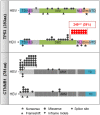Integration of tumour and viral genomic characterizations in HBV-related hepatocellular carcinomas
- PMID: 25021421
- PMCID: PMC4392232
- DOI: 10.1136/gutjnl-2013-306228
Integration of tumour and viral genomic characterizations in HBV-related hepatocellular carcinomas
Abstract
Background and aim: Hepatocellular carcinoma (HCC) is the most common liver cancer. We characterised HCC associated with infection compared with non-HBV-related HCC to understand interactions between viral and hepatocyte genomic alterations and their relationships with clinical features.
Methods: Frozen HBV (n=86) or non-HBV-related (n=90) HCC were collected in two French surgical departments. Viral characterisation was performed by sequencing HBS and HBX genes and quantifying HBV DNA and cccDNA. Nine genes were screened for somatic mutations and expression profiling of 37 genes involved in hepatocarcinogenesis was studied.
Results: HBX revealed frequent non-sense, frameshift and deletions in tumours, suggesting an HBX inactivation selected in HCC. The number of viral copies was frequently lower in tumour than in non-tumour tissues (p=0.0005) and patients with low HBV copies in the non-tumour liver tissues presented additional risk factor (HCV, alcohol or non-alcoholic steato-hepatitis, p=0.006). P53 was the most frequently altered pathway in HBV-related HCC (47%, p=0.001). Furthermore, TP53 mutations were associated with shorter survival only in HBV-related HCC (p=0.02) whereas R249S mutations were identified exclusively in migrants. Compared with other aetiologies, HBV-HCC were more frequently classified in tumours subgroups with upregulation of genes involved in cell-cycle regulation and a progenitor phenotype. Finally, in HBV-related HCC, transcriptomic profiles were associated with specific gene mutations (HBX, TP53, IRF2, AXIN1 and CTNNB1).
Conclusions: Integrated genomic characterisation of HBV and non-HBV-related HCC emphasised the immense molecular diversity of HCC closely related to aetiologies that could impact clinical care of HCC patients.
Keywords: HEPATITIS B; HEPATOCELLULAR CARCINOMA.
Published by the BMJ Publishing Group Limited. For permission to use (where not already granted under a licence) please go to http://group.bmj.com/group/rights-licensing/permissions.
Figures





Comment in
-
Virus-host interactions in HBV-related hepatocellular carcinoma: more to be revealed?Gut. 2015 May;64(5):852-3. doi: 10.1136/gutjnl-2014-308283. Epub 2014 Sep 8. Gut. 2015. PMID: 25200746 No abstract available.
-
Authors' response: virus-host interactions in HBV-related hepatocellular carcinoma: more to be revealed?Gut. 2015 May;64(5):853-4. doi: 10.1136/gutjnl-2014-308482. Epub 2014 Oct 20. Gut. 2015. PMID: 25331453 No abstract available.
References
-
- El-Serag HB, Rudolph KL. Hepatocellular carcinoma: epidemiology and molecular carcinogenesis. Gastroenterology 2007;132:2557–76. - PubMed
-
- El-Serag HB. Hepatocellular carcinoma. N Engl J Med 2011;365:1118–27. - PubMed
-
- Arzumanyan A, Reis HM, Feitelson MA. Pathogenic mechanisms in HBV- and HCV-associated hepatocellular carcinoma. Nat Rev Cancer 2013;13:123–35. - PubMed
Publication types
MeSH terms
Substances
LinkOut - more resources
Full Text Sources
Other Literature Sources
Medical
Research Materials
Miscellaneous
